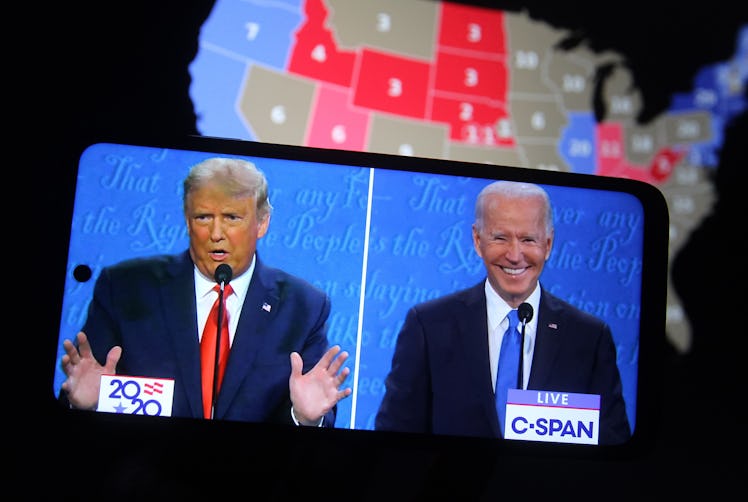
Here's What Happens If Trump & Biden Wind Up In A Tie For Electoral Votes
Although Election Day has passed, as of 10 a.m. ET on Nov. 6, there's still no confirmed winner in the 2020 general election. The results so far have made it hard to keep tabs on whether President Donald Trump or former Vice President Joe Biden will win the presidency, but the wait could be over soon if Biden reaches that simple majority of 270 votes in the Electoral College. As of 10 a.m. ET on Friday, Nov. 6, Biden is leading with 253 electoral votes, with Trump behind at 214, per The New York Times tracker, but what happens if there's a tie in the Electoral College? Here's what could go down if votes come out equal.
The math is tricky, and news outlets have been judging states as "called" differently, but here's how it could play out. As of 10 a.m. ET, Biden is leading by narrow margins in Pennsylvania and Georgia, per the Times tracker, but if Trump were to come back and win the electoral votes in Pennsylvania (with 20 electoral votes) and Biden hangs on in Georgia (16 electoral votes), that would put Biden at 269 and Trump at 234. If Trump then went on to win Alaska, Nevada, Arizona (which has not been definitively called), and North Carolina, with three, six, 11, and 15 electoral votes, respectively, he would also be at 269. The Electoral College has a total of 538 votes, making that an even split. This scenario is, of course, very, very unlikely — but weirder things have happened in 2020.
The Electoral College meets on Dec. 14 to officially submit votes, but if there's a confirmed tie, the votes will go to the House immediately, per the 12th Amendment, which will vote as state delegations. That means all representatives from each state band together and cast one vote, no matter the state's population or the number of representatives. To win the presidency, Biden or Trump will need the votes of at least 26 state delegations.
A tie in the Electoral College is rare, but not impossible. The first and last time there was a tie was in 1800, in the election between Aaron Burr and Thomas Jefferson, per History.com. At that time, it was decided by the House of Representatives after reaching 36 votes for Jefferson. According to USA Today, the same thing would happen should a tie be the end result of the 2020 election, according to Article II, Section 1 of the Constitution. The Constitution clearly lays out that the House of Representatives chooses the president if there is a tie in the Electoral College — and the vice president is chosen by the Senate.
As of Friday, Nov. 6, there are a total of 209 Democratic representatives and 193 Republican representatives confirmed to have won their 2020 elections so far, and to have House control a political party needs 218 seats, per The New York Times. However, regardless of a House majority overall, the majority of individual state delegations could sway the outcome of the final vote, since each state's vote carries the same weight. Basically, even with Democratic control of the House, if there are more Republican delegations, that could signal the outcome of the House vote.
The vote for the vice president in the Senate would work differently, with each member of the Senate getting a vote. A vice president needs a minimum of 51 Senate votes to win. So while a tie wouldn't be ideal, it is something the Constitution has a process for.
Even though a tie in the Electoral College is unlikely for the 2020 election, it is a possibility as results remain inconclusive and tallies keep coming in.